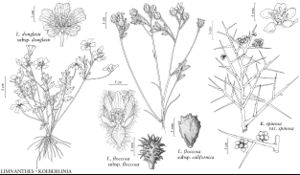Koeberliniaceae
Shrubs or trees (deciduous); (thorny) spines absent: glabrous or glabrate. Stems erect; profusely branched. Leaves alternate, spirally arranged, (minute, scalelike); venation pinnate; stipules present (caducous, scalelike); petiole absent. Inflorescences axillary, racemose, corymbose, or flowers solitary; pedunculate; bud scales usually persistent; bracts usually absent, sometimes present. Pedicels present. Flowers bisexual, actinomorphic, rotate to crateriform, campanulate, or urceolate; perianth and androecium hypogynous; sepals persistent, 4, distinct or connate basally; petals 4, attached directly to receptacle, imbricate, distinct, equal; intrastaminal nectary-discs or glands usually present; stamens 8; filaments distinct, glabrous or pubescent; anthers dehiscing bylongitudinal slits; pistil 1; ovary 1-carpellate, 2-locular; placentation axile; ovules anatropous, bitegmic; style 1 (straight, short and thick); stigma 1, capitate, unlobed. Fruits: berries, indehiscent (spheroidal). Seeds (1 or) 2–4, blackish; not arillate; endosperm scanty or absent, sometimes a persistent perisperm present; cotyledons incumbent. x = 11.
Distribution
sw North America, n Mexico, South America (Bolivia).
Discussion
Genus 1, species 2 (1 in the flora).
Koeberlinia has been included in the traditional Capparaceae by some authors, including A. Cronquist (1981). Recent molecular studies support its removal from Capparaceae and a relationship with Bataceae and Salvadoraceae (P. F. Stevens, www.mobot.org/MOBOT/research/APweb).
